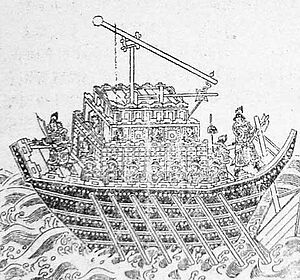Battle of Tangdao facts for kids
Quick facts for kids Battle of Tangdao |
|||||||
|---|---|---|---|---|---|---|---|
| Part of the Jin–Song Wars | |||||||
 |
|||||||
|
|||||||
| Belligerents | |||||||
| Jurchen Jin | Southern Song | ||||||
| Commanders and leaders | |||||||
| Su Baoheng Wanyan Zhengjianu † |
Li Bao | ||||||
| Strength | |||||||
| 600 warships 20,000 Jurchen and Balhae troops 10,000 Northern Chinese 40,000 sailors |
120 warships and 3000 troops | ||||||
| Casualties and losses | |||||||
| 10,000 300 warships |
|||||||
The Battle of Tangdao was a major naval battle. It happened in 1161 on the East China Sea. This fight was between the Jurchen Jin and the Southern Song dynasty of China. The battle took place near Tangdao Island. It was part of the larger Jin-Song wars. The Jin dynasty wanted to invade and conquer the Southern Song dynasty. However, they failed and were defeated.
During the battle, the Jin dynasty navy faced heavy losses. Their ships were set on fire by huopao. These were a type of gunpowder weapon, possibly early cannons. Fire arrows were also used. The Song dynasty squadron was led by Commander Li Bao. The Jin dynasty admiral was Zheng Jia.
Contents
What Happened at Tangdao?
The Jin dynasty fleet was very large. It had 600 warships and many soldiers. But their admiral, Zheng Jia, was not familiar with sea routes. He also didn't know much about managing ships. Suddenly, the Song ships appeared. They caught the Jin fleet by surprise.
The Song forces used special weapons. They threw incendiary gunpowder projectiles onto the Jin ships. These weapons caused the Jin ships to catch fire. Many ships were soon burning. Seeing his fleet destroyed, Zheng Jia had no way to escape. He jumped into the sea and drowned. This was a huge defeat for the Jin dynasty.
Why Was This Battle Important?
This battle was a big victory for the Southern Song dynasty. It showed the power of their navy. It also highlighted their advanced technology. The Song navy was growing stronger. They were always inventing new things.
The Song era was a time of great invention. The Song navy grew a lot. It went from 11 squadrons and 3,000 men. In one century, it grew to 20 squadrons and 52,000 men. Their main base was near Shanghai. Chinese merchants who traveled by sea also helped the navy.
- Gunpowder Bombs: By 1129, the Song navy had invented gunpowder bombs. These were used with trebuchets on warships. Every ship in the Song fleet had to carry these bombs.
- Paddle-Wheel Ships: The Song also built paddle-wheel ships. These ships were powered by treadmills. Engineers worked on these ships for decades. One engineer, Gao Xuan, designed a ship with eleven paddle-wheels on each side.
- Iron Plating: In 1203, an engineer named Qin Shifu designed iron plating. This was used to armor the ships. It made them much tougher.
These new technologies helped the Song navy. They gave them control of the East China Sea. This was important for centuries. It helped them compete against rivals like the Jurchen and Mongol forces.
The Battle's Impact
Commander Li Bao ordered his men to attack fiercely. They threw their huopao (early grenades). They also fired many incendiary arrows and rockets. These were aimed at the sails and rigging of the enemy ships. The Jin officers were shocked by the strong attack.
The Jin ships had red sails made of oiled silk. These sails quickly caught fire. As the ships burned, the Jin crew and soldiers panicked. Many jumped into the sea. Some Jin ships surrendered. Others tried to escape by raising anchor and sailing away.
This battle was followed by another naval fight. It was called the Battle of Caishi. That battle also took place in 1161. Both battles showed the strength of the Song navy. They also showed the importance of new military technology.
See also
- Naval warfare
- Maritime history
- Naval history of China
- Military history of China (pre-1911)
- Jin–Song Wars
- Timeline of the Jin–Song wars
- History of the Song dynasty
- Technology of the Song dynasty
- Gunpowder warfare
- Jiao Yu

